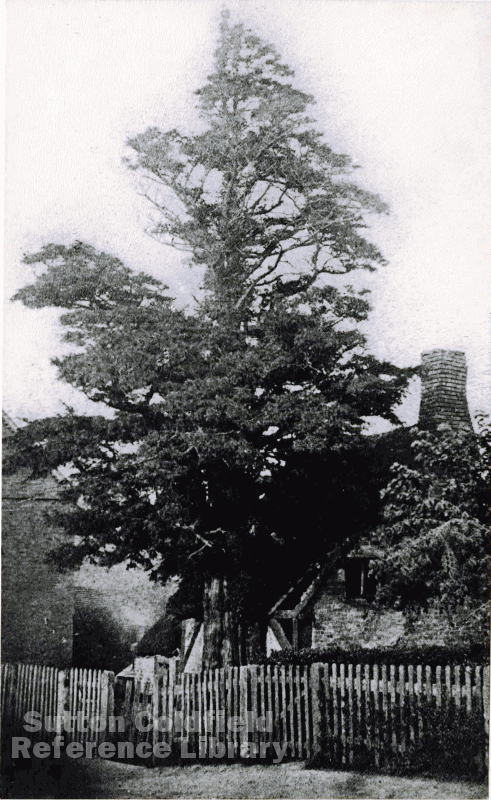Peers’ 1870 Guide to Sutton Coldfield includes a history of the town in which he describes a cottage “with a large yew tree before the door on the north side of the Birmingham Road; which is the oldest the house or the tree, cannot be told, but both have seen centuries. For more than a century it was the only wheelwright’s shop in the place. The roots of the tree have extended under the house in all directions, so that when the wind blows on stormy nights, swaying the tree to and fro, the house rocks from side to side; but so firmly is the oaken frame which forms the house linked together, that however strong the storm the house suffers no damage”.
Peers must have been very impressed by this story, which is inserted in the middle of his account of Sutton’s medieval history. The site of this house, known as Yew Tree Cottage, is not quite where Peers says, being on the corner of South Parade and Lower Parade opposite the library; in 1824 it was listed as “house, garden and wheelwright’s shop” in the occupation of Thomas Hayward, wheelwright. Peers also says (wrongly) that visitors going from the railway station to Sutton Park would pass by the White Cottage, where, according to Holbeche, lived Thomas Hayward’s son -“He was a wheelwright and had a wooden shed just where the entrance to the Manor Road now is.” If this shed was a wheewright’s shop, then the one at Yew Tree Cottage was not the only wheelwright’s shop in Sutton. Records show that the Old Smithy at Maney included a wheelwright’s shop in 1856, and there was another at Mere Green.
The Haywards prospered through their trade, and so did another wheelwright in the previous century. Richard Reynolds, a wheelwright by trade, was expanding his business - in March 1754 the Warden and Society granted a lease to him to erect a house, watercorn mill and dressing mill at Longmoor Pool “for the more commodious grinding of corn for the inhabitants of Sutton Coldfield and other adjacent parishes”
In 1683 the miller at Hill Hook Mill described himself as a “wheelmaker”. This was in William Bickley’s will, dated October 11th 1683, in which he bequeaths “unto my son John all that my interest or title whatsoever of that my mill now in my possession with the crow hammer and picks together with all my shop tools”. The inventory of his goods and chattels which accompanies the will includes “one crow(bar) one sledgehamber with some picks”, presumably the chief tools of the wheelwright, total value four shillings. Bickley’s craft does not appear to have been very prosperous, as the total value of all his goods was only £17 14s. 6d.
